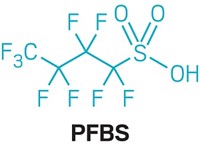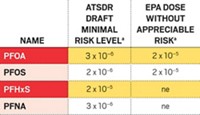Advertisement
Grab your lab coat. Let's get started
Welcome!
Welcome!
Create an account below to get 6 C&EN articles per month, receive newsletters and more - all free.
It seems this is your first time logging in online. Please enter the following information to continue.
As an ACS member you automatically get access to this site. All we need is few more details to create your reading experience.
Not you? Sign in with a different account.
Not you? Sign in with a different account.
ERROR 1
ERROR 1
ERROR 2
ERROR 2
ERROR 2
ERROR 2
ERROR 2
Password and Confirm password must match.
If you have an ACS member number, please enter it here so we can link this account to your membership. (optional)
ERROR 2
ACS values your privacy. By submitting your information, you are gaining access to C&EN and subscribing to our weekly newsletter. We use the information you provide to make your reading experience better, and we will never sell your data to third party members.
Environment
Assessing Perchloroethylene
EPA: New values may lead to tighter regulation in drinking water and air, but no additional cleanup at Superfund sites
by Cheryl Hogue
February 10, 2012
A new scientific assessment of perchloroethylene (perc), released by the Environmental Protection Agency today, may lead to tighter regulation of the chemical in drinking water and in air emissions. But it may also spell relief for the cleanup of Superfund hazardous waste sites.
Perc, also known as tetrachloroethylene, is a solvent widely used for dry cleaning. However, EPA says the wearing of clothes that are dry cleaned with perc is not likely to cause exposures of concern for health effects.
The assessment does two things. First it sets a safe daily dose of 0.006 mg of perc per kg of body weight, on the basis of studies that found neurotoxic effects in workers exposed to the chemical. This replaces a safe dose that EPA set in 1988 of 0.01 mg/kg/day, on the basis of laboratory studies in rats.
Second, the assessment categorizes perc as a likely human carcinogen, a conclusion affirmed by the National Research Council in a 2010 report.
EPA says it will use the data in the assessment as it revises its maximum contaminant level for perc in drinking water.
In addition, the agency will use the safe daily dose and carcinogenicity information to establish cleanup levels at hundreds of Superfund sites contaminated with perc. What’s more, the assessment will relax cleanup levels required when homes near Superfund sites have perc as an indoor air pollutant. Thus, the agency explains, “no additional cleanup will need to be done at any previously cleaned Superfund sites.”
EPA says it will also use the new toxicity values in the assessment as it evaluates whether to ratchet down allowable emissions of perc into air. The compound is tightly regulated as a hazardous air pollutant under the Clean Air Act.





Join the conversation
Contact the reporter
Submit a Letter to the Editor for publication
Engage with us on Twitter